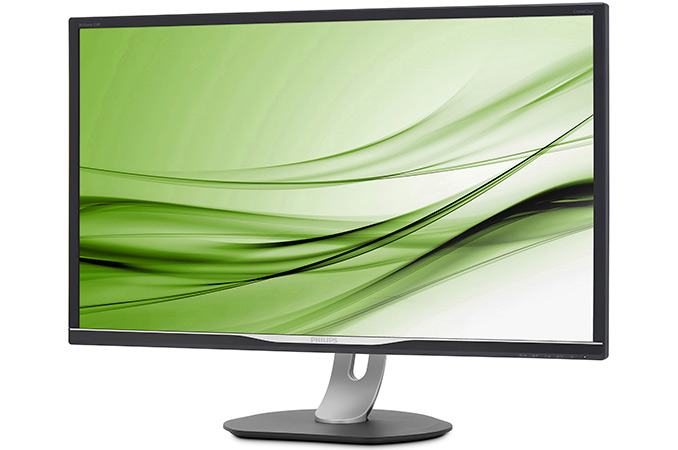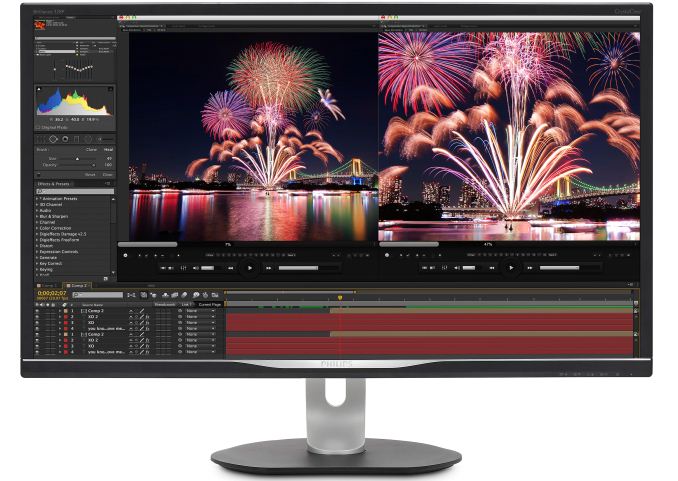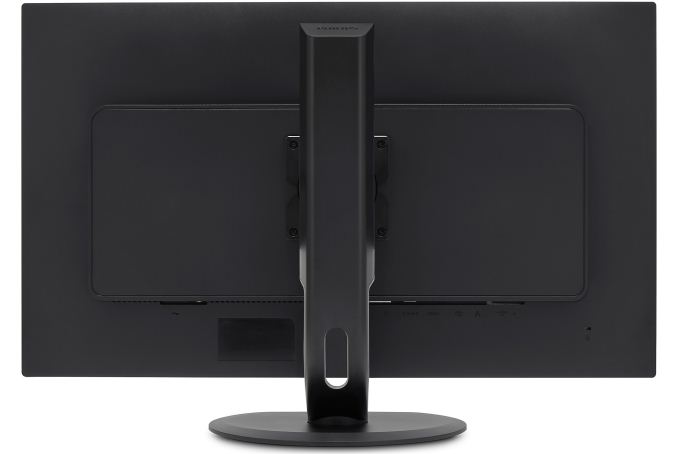Philips Preps 328P6AU and 328P6VU: 31.5” Professional LCDs with QHD, UHD, HDR, USB-C
by Anton Shilov on September 18, 2017 4:15 PM EST
Philips announced two professional displays with HDR support at IFA earlier this month. The new 328P6AU and 328P6VU monitors offer QHD and UHD 4K resolutions respectively, while both monitors feature wide color gamuts (which means higher-than-sRGB) as well as USB Type-C inputs, in accordance with recent market trends. The monitors will be aimed at the high end of the market, but are not going to to be too expensive.
The first of the new P-series displays to arrive is the Philips 328P6AU (pictured). The monitor is based on an IPS-ADS panel with a 2560×1440 resolution and can hit 400 nits in brightness. Philips says that the 328P6AU display can reproduce 98% of the AdobeRGB color gamut (and therefore it is safe to say that it can cover 100% of the sRGB), but it does not reveal anything beyond that. The firm also is not disclosing the refresh rate of the panel, but given how the monitor is being positioned, it is likely that it is set at 60 Hz. Since the 328P6AU is a professional display, its stand can set the monitor in portrait mode and allows all kinds of other adjustments (height, rotate, tilt).
The second P-series LCD that Philips is working on is called the 328P6VU, and this one is substantially more advanced. The monitor is based on an IPS-AAS panel featuring a 3840×2160 resolution and can hit 600 nits in brightness, which is considerably higher compared to numerous contemporary displays for professionals. Furthermore, the 328P6VU is equipped with a backlighting supporting 16-zone local dimming, so expect a fairly high contrast ratio. As for color gamut, Philips only mentions 95% of NTSC, but nothing else. Again, the company isn't publishing anything about the refresh rate of the LCD, but 60 Hz is a reasonable guess.
When it comes to connectivity, the 328P6AU and 328P6VU both have the same functionality. Both monitors include DisplayPort, HDMI, and D-Sub (VGA) inputs (this one seems a bit odd on a 4K model, but could be useful for PiP) as well as a USB-C port. The latter can be used as a display input as well as an upstream port for a hub featuring USB 3.0 ports and a GbE connector. Such a hub will be very useful for those with notebooks featuring USB-C and lacking other connectors (e.g. MacBooks). Finally, the monitors will have two 3 W stereo speakers.
| Specifications of Philips P6-Series Displays | ||
| 328P6AU | 328P6VU | |
| Panel | 31.5" IPS ADS | 31.5" IPS AAS |
| Native Resolution | 2560 × 1440 | 3840 × 2160 |
| Maximum Refresh Rate | 60 Hz (?) | |
| Brightness | 400 cd/m² | 600 cd/m² |
| Local Dimming | None | 16 zone |
| Contrast | unknown | high |
| Viewing Angles | 178°/178° horizontal/vertical | |
| HDR | "Supported" | |
| Pixel Pitch | 0.2724 mm² | 0.1816 mm² |
| Pixel Density | 93 PPI | 140 PPI |
| Color Gamut Support | AdobeRGB: 98% | NTSC: 95% |
| Stand | Tilt, pivot (90°) and height adjustable | Unknown, but likely same as on the 328P6AU |
| Inputs | 1 × DisplayPort 1.2 1 × HDMI 2.0a 1 × USB Type-C (DP 1.2) 1 × D-Sub |
|
| USB Hub | multi-port USB 3.0 hub | |
| Ethernet | GbE port | |
| Audio | 3 W × 2 | |
| Launch Timeframe | October 2017 | Q1 2018 |
| Launch Price | TBA | €529 – €549 ($632 – $655) in Europe |
As for pricing and availability, the Philips 328P6AU is set to hit the market next month with a price to be announced. I don't expect this one to be all that expensive, but its price is not going to be a bargain given that it's aimed at professionals. Meanwhile the Philips 328P6VU is set to arrive sometimes in Q1 2018 and the manufacturer plans to sell it for approximately €529 – €549 in Europe ($632 – $655), which is surprisingly competitive for a 4K display with a USB-C input, a USB hub, and a Gigabit Ethernet port.
Related Reading:
- Philips Readies Curved Ultra-Wide 492P8 Display: 49”, 32:9, USB-C, Sub-$1100
- Philips Demos 328P8K: 8K UHD LCD with Webcam, Docking, Coming in 2018
- Philips BDM4037UW Goes on Sale: 40 Inch 4K Curved Display for $800
- Philips Begins to Sell 43” 4K IPS BDM4350UC Display for $799
- Philips Begins Shipments of LCD Monitors with Quantum Dot Technology
Source: Philips/TPV












20 Comments
View All Comments
Hurr Durr - Monday, September 18, 2017 - link
Ethernet. In a display. Why.ddriver - Monday, September 18, 2017 - link
For monitor viruses.BillBear - Monday, September 18, 2017 - link
Laptops. That dock and undock with a single plug. Convenient.edzieba - Monday, September 18, 2017 - link
To use the display as a laptop dock without needing to hang an extra dongle from it. Why plug in four cables (USB plus DP plus ethernet plus power) when you sit down at your desk when you can just plug in one?CheapSushi - Friday, September 22, 2017 - link
I wish more monitors had that. Would be great for multi-monitors in a homelab. Would be even better if PoE (powered ethernet).lowphas - Monday, September 18, 2017 - link
I don't think that the "16 zone local dimming" makes a huge difference.DanNeely - Monday, September 18, 2017 - link
I tend to agree; we can argue about how many zones is enough and the ~1 inch rectangles that the 24x16(?) grid in the 384 zone panels that've been being teased all summer makes a reasonable case for being adequate event if I do want to see it in person before giving final judgement. But 16 zones means a 4x4 dimming grid and 7x4" zones, which seems absurdly coarse detail.ddriver - Monday, September 18, 2017 - link
It will save some power, may offer better contrast in some scenarios, but mostly power.nathanddrews - Tuesday, September 19, 2017 - link
I much prefer a minimum of 24,883,200 dimming zones.ddriver - Tuesday, September 19, 2017 - link
Buy oled then ;)